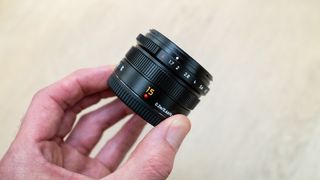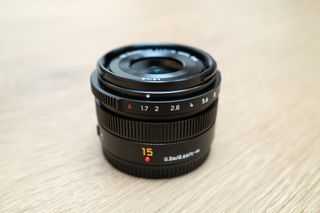Main specifications
type: single focus lens
Focal length: 15mm (equivalent to 30mm)
Maximum aperture: f/1.7
Lens mount: micro four thirds
Weight: 4.06oz/115g
size: 1.42×2.26 inch / 36×57.5 mm
Filter thread: 46mm
release date: March 2014
In the fast-paced world of photography where new kits are constantly being released, you may be wondering where a 10-year-old lens fits into the equation. The Panasonic Leica Summilux DG 15mm f/1.7 ASPH continues to be a great prime lens for Micro Four Thirds (MFT) cameras thanks to its compact size, light weight, and solid overall performance. This lens offers a full-frame equivalent focal length of 30mm, making it versatile for a variety of subjects.
Thanks to its versatile focal length and bright maximum aperture of f/1.7, this lens can be used for landscapes, cityscapes, street photography, and of course astrophotography. The latter, along with the former, makes it an attractive option for astrophotographers shooting with Panasonic or OM System (Olympus) cameras. Many astrophotographers shoot with ultra-wide-angle lenses to capture as much of the night sky as possible, but sometimes a narrower field of view is needed and a prime lens around 30mm is often the best choice. It becomes a choice. This allows you to incorporate foreground elements such as structures and the landscape itself while providing a wide enough field of view to include the night sky.
The Panasonic 15mm is reasonably priced at $498 / £499 considering its durable metal design and excellent build quality. This lens isn’t the fastest or widest of Panasonic’s lenses, but when attached to one of the best mirrorless cameras it performs well when photographing the night sky along with other popular subjects. By providing this, it definitely demonstrates its unique performance.
Panasonic Leica Summilux DG 15mm f/1.7 ASPH: Design
- compact and lightweight
- manual aperture ring
- Manual/autofocus switching
What immediately strikes you about this lens is how compact and lightweight it is. At just 1.42×2.26 inches / 36×57.5 mm and weighing 4.06 oz / 115 g, you’ll hardly notice that the Panasonic 15mm is attached to your camera.
This is certainly not a bad thing if you often hike to dark areas away from light pollution. Not to mention, a lighter lens means you can carry more with you, giving you more options while shooting on location.
The lens features a durable metal design and is well constructed despite being lightweight. Designed for photography and video, it has a manual aperture ring, manual focus ring, and a manual/autofocus switch on the side. There are no extra features here. It has everything you need in a simple single vision lens.
The Panasonic 15mm consists of 9 lenses in 7 groups, including 3 aspherical lenses. The aperture consists of seven aperture blades. More aperture blades will make the aperture more circular and produce a more circular bokeh, but for astrophotography shot at f/1.7 this isn’t important.
The Panasonic 15mm is a very compact lens, so while it may not seem suitable for professional use, it can perfectly meet the needs of more demanding photographers. MFT lenses, even longer telephoto prime lenses, are significantly smaller and lighter than their full-frame counterparts, so the Panasonic 15mm’s design is unsurprising and fits nicely into the system.
Panasonic Leica Summilux DG 15mm f/1.7 ASPH: Functionality

- No optical image stabilization
- Fast and quiet autofocus
- Shortest shooting distance
Being a fairly standard prime lens, the Panasonic 15mm doesn’t have the bells and whistles of more expensive full-frame prime lenses. It doesn’t have optical image stabilization, but that’s not a problem since most Panasonic Lumix cameras have in-body image stabilization (IBIS).
Optical image stabilization significantly increases the size, weight, and cost of the lens, so it’s okay to not have optical image stabilization. Additionally, this is not a feature that astrophotographers use when photographing the night sky, so in some ways there is no real loss.
Autofocus is fast and quiet, making it ideal for photos and videos. The latter is especially useful as it means videographers can use autofocus in parallel with the on-camera microphone without picking up the sound of the lens focusing. In practice, most videographers use manual focus, but it’s also useful for those who use autofocus.
As mentioned earlier, the Panasonic 15mm has a manual aperture ring that covers all apertures from f/1.7 to f/16. There’s also an A setting that lets you change the aperture using the camera controls, so you can choose what works best for you.
The minimum focusing distance is only 7.92 inches / 20 cm. This means you can get much closer to your subject, further expanding the creative possibilities of the lens.
Panasonic Leica Summilux DG 15mm f/1.7 ASPH: Performance

- great image quality
- Vignetting from wide open
- The sweet spot of the lens is F4
Prime lenses traditionally produce better image quality than zoom lenses, but the Panasonic 15mm fits perfectly into this narrative with its overall superior image quality. What’s particularly interesting here is that images taken at the maximum f/1.7 aperture are perfectly sharp in the center area of the frame. This is good news for astrophotographers. However, there is some distortion and vignetting, but this can be easily corrected in software like Lightroom, and details remain sharp. There is less sharpness in the corners compared to shots taken at f/4, but this is to be expected as this is common with most large prime lenses. This lens performs best in terms of sharpness between f/2.8 and f/4.
While f/4 itself seems to be the lens’ sweet spot where the most detail is captured throughout the image, the central area of the photo taken at f/1.7 is more than adequate.
This aperture allowed me to capture the Northern Lights at just ISO 800, while night shots under full moon light required only ISO 400. This lens was tested in conjunction with the Panasonic Lumix GH7 and provided a highly effective kit. To take pictures of the night sky.
Panasonic Leica Summilux DG 15mm f/1.7 ASPH: Price
At just $498/£499, the Panasonic Leica Summilux DG 15mm f/1.7 ASPH is an affordable addition to the Panasonic lens range. Some prime lenses are more expensive, while others are less expensive, but they don’t always offer a good balance between cost, build quality, optical performance, features, and ease of use.
When you purchase a lens, you will also receive a lens cap, lens rear cap, lens hood, lens hood cap, and lens storage bag. This is standard with almost every lens, and the most useful accessory is a lens hood to protect the lens from direct light that can cause flare.
Should I buy the Panasonic Leica Summilux DG 15mm f/1.7 ASPH?
If you need an MFT lens with a 30mm equivalent focal length, there’s no reason not to buy the Panasonic Leica Summilux DG 15mm f/1.7 ASPH. This fast prime lens produces excellent image quality, but it’s not perfect. Major optical defects can be easily corrected with software such as Adobe Lightroom.
Compared to full-frame cameras, the greater depth of field produced by MFT cameras and lenses allows foreground elements in astrophotography to be perfectly sharp when shot at maximum aperture. The advantage here is greater depth of field with the same light-gathering ability.
The only time you might not want this lens is if you want a prime lens with an 18mm, 24mm, or 50mm equivalent focal length, and there are alternative options available.
If this lens isn’t right for you
There are currently no reviews for other Micro Four Thirds short prime lenses on Space, but we plan to add more reviews to the website to provide you with the best MFT lens options for astrophotography.
This doesn’t mean there aren’t other great options available at a variety of price points to suit every budget. This includes premium Panasonic Leica Summilux DG 12mm f/1.4 ASPH It has a super fast maximum aperture and a 24mm equivalent focal length.
For a more budget-friendly option, Panasonic Leica Summilux DG 25mm f/1.4 II ASPH With a focal length equivalent to 50mm, Panasonic Leica Summilux DG 9mm f/1.7 ASPH It has an amazingly wide angle with a focal length equivalent to 18mm.








